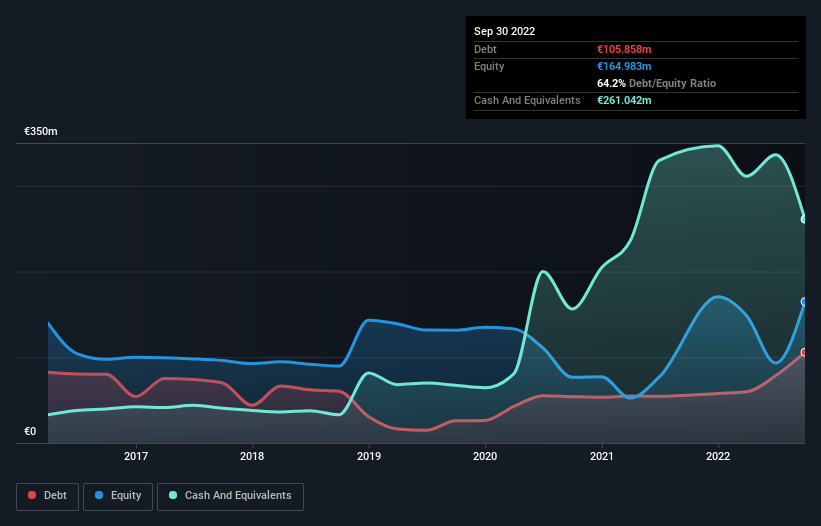
The external fund manager backed by Berkshire Hathaway's Charlie Munger, Li Lu, makes no bones about it when he says 'The biggest investment risk is not the volatility of prices, but whether you will suffer a permanent loss of capital.' So it seems the smart money knows that debt - which is usually involved in bankruptcies - is a very important factor, when you assess how risky a company is. We can see that Valneva SE ( EPA:VLA ) does use debt in its business. But the real question is whether this debt is making the company risky.
When Is Debt A Problem?
Generally speaking, debt only becomes a real problem when a company can't easily pay it off, either by raising capital or with its own cash flow. If things get really bad, the lenders can take control of the business. However, a more frequent (but still costly) occurrence is where a company must issue shares at bargain-basement prices, permanently diluting shareholders, just to shore up its balance sheet. Having said that, the most common situation is where a company manages its debt reasonably well - and to its own advantage. When we think about a company's use of debt, we first look at cash and debt together.
View our latest analysis for Valneva
What Is Valneva's Net Debt?
You can click the graphic below for the historical numbers, but it shows that as of September 2022 Valneva had €105.9m of debt, an increase on €57.8m, over one year. But it also has €261.0m in cash to offset that, meaning it has €155.2m net cash.

A Look At Valneva's Liabilities
According to the last reported balance sheet, Valneva had liabilities of €374.2m due within 12 months, and liabilities of €158.9m due beyond 12 months. Offsetting this, it had €261.0m in cash and €57.7m in receivables that were due within 12 months. So its liabilities outweigh the sum of its cash and (near-term) receivables by €214.3m. The company raised around €103 million in October last year which does bolster its cash position to some extent. But we definitely want to keep our eyes open to indications that its debt is bringing too much risk. Despite its noteworthy liabilities, Valneva boasts net cash, so it's fair to say it does not have a heavy debt load!
Notably, Valneva made a loss at the EBIT level, last year, but improved that to positive EBIT of €27m in the last twelve months. When analysing debt levels, the balance sheet is the obvious place to start. But ultimately the future profitability of the business will decide if Valneva can strengthen its balance sheet over time. So if you're focused on the future you can check out this free report showing analyst profit forecasts .
Finally, a business needs free cash flow to pay off debt; accounting profits just don't cut it. Valneva may have net cash on the balance sheet, but it is still interesting to look at how well the business converts its earnings before interest and tax (EBIT) to free cash flow, because that will influence both its need for, and its capacity to manage debt. During the last year, Valneva burned a lot of cash. While that may be a result of expenditure for growth, it does make the debt far more risky.
Summing Up
Although Valneva's balance sheet isn't particularly strong, due to the total liabilities, it is clearly positive to see that it has net cash of €155.2m. So although we see some areas for improvement, we're not too worried about Valneva's balance sheet. There's no doubt that we learn most about debt from the balance sheet. However, not all investment risk resides within the balance sheet - far from it. For instance, we've identified 3 warning signs for Valneva that you should be aware of.
When all is said and done, sometimes its easier to focus on companies that don't even need debt. Readers can access a list of growth stocks with zero net debt 100% free , right now.
New: Manage All Your Stock Portfolios in One Place
We've created the ultimate portfolio companion for stock investors, and it's free.
• Connect an unlimited number of Portfolios and see your total in one currency
• Be alerted to new Warning Signs or Risks via email or mobile
• Track the Fair Value of your stocks
Have feedback on this article? Concerned about the content? Get in touch with us directly. Alternatively, email editorial-team (at) simplywallst.com.
This article by Simply Wall St is general in nature. We provide commentary based on historical data and analyst forecasts only using an unbiased methodology and our articles are not intended to be financial advice. It does not constitute a recommendation to buy or sell any stock, and does not take account of your objectives, or your financial situation. We aim to bring you long-term focused analysis driven by fundamental data. Note that our analysis may not factor in the latest price-sensitive company announcements or qualitative material. Simply Wall St has no position in any stocks mentioned.
About ENXTPA:VLA
Valneva
A specialty vaccine company, develops, manufactures, and commercializes prophylactic vaccines for infectious diseases with unmet needs.
Undervalued with high growth potential.
Similar Companies
Market Insights
Community Narratives



